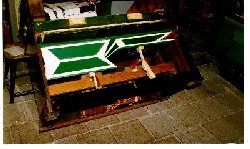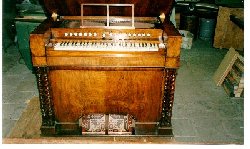Method
Before I start a reed organ restoration, I always try to find out what the original construction of the instrument was. For this purpose I use photo’s of similar instruments, old catalogs, and also by thorough investigation of the instrument itself.
When restoring historical instruments, I always try to use the same materials as originally used by the manufacturer. In my opinion a restoration must be done by using historical materials, or material that fits with the materials originally used as much as possible.
When working with reed organs, I am always impressed by the beautiful techniques and methods used by the manufacturer. It is impressive, when you realize under which circumstances and with which limited resources the instruments are made.
When you realize this, you only can have a great respect for the instruments they have made..
Here is a photo-report on the restoration of a harmonium.
It is an English pressure harmonium, an Evans from 1865. When I saw the instrument the first time, the bellows were leaky,
the internals needed repair, and even some parts were missing. And a loth of more problems!!
The complete instrument has been dismantled and cleaned. Next I have made the missing parts from the same material they where
originally made of. When all the parts were completed and in working order, the instrument was rebuild again.
Now the instrument is used again by the Centrum New Choir Music in Amsterdam, and is a beautiful piece of furniture again. And the harmonium itself?? SUPERBE!!
 | The pieces of the case are cleaned and repaired. |
 | The pedals and the bellows are repaired. The bellows are repaired by using new linen and leather, using the original colors. |
 | The result: a reborn instrument. |